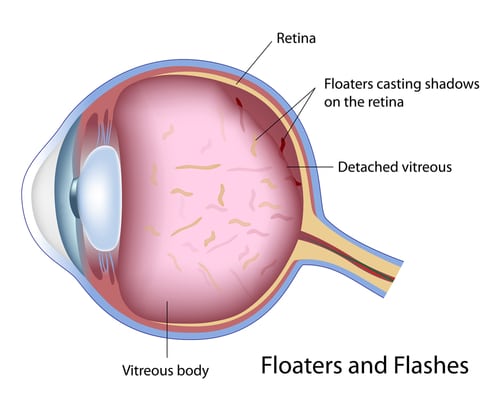Flashes and floaters can be a sign of a condition called posterior vitreous detachment (PVD). Although this sounds like retinal detachment is it usually much less serious.


Most of the liquid volume of the eye is composed of a fluid called vitreous. This fluid is thick, gel-like, sticky, and very similar to uncooked egg white. As we age, the gel of the vitreous becomes more liquid and the gel contracts. When this happens, the places where the sticky gel contacts the inner wallpaper of the eye (the retina) get tugged. The retina does not have nerve fibers that transmit pain signals, but when stimulated these nerve fibers do transmit signals to the brain that shout “I see light”. This is what produces the peripheral, arc shaped flashes that patients see that we call Morse Lightening. These flashes can last several weeks as the vitreous completes its detachment. As the adherent areas pull away from the retina, microscopic opaque connective tissue gets pulled into the fluid in front of the retina. Imagine a small piece of eggshell floating in egg white. Even thought these structures are mostly clear, light entering the eye is blocked by the opacity and casts a shadow on the retina that the patient sees as one or many black or silvery dots, gnats, rings, or strings. Just like the picture below of clear glass mugs casting shadows. As the gel and fluid inside of the eye moves, the opacity moves along with it in a “floating” motion.

In some cases the separation of the connective tissue between the vitreous and the retina can be disruptive enough to actually cause bleeding, a tear in the retina, or a retinal detachment. Signs of this can be lots of constant flashing lights, tens to hundreds of floaters all at once, or a veil or curtain that seems to cover an area of the visual field. Any of these signs should be reported to your eyecare provider for a careful evaluation as soon as possible.
The timing of when we see floaters often depends on lighting conditions. Uniform, light, bright backgrouds like computer screens, the sky, white sheets of paper, and such are where floaters tend to be the most visible. PVDs tend to happen around age 40 and also can happen following cataract surgery and other eye surgeries where surgical manipulation and fluids can shake up the vitreous.
The risks of surgically removing floaters with vitrectomy often outweigh the benefits. So, give them a name, and call them a friend … they will always be around.


